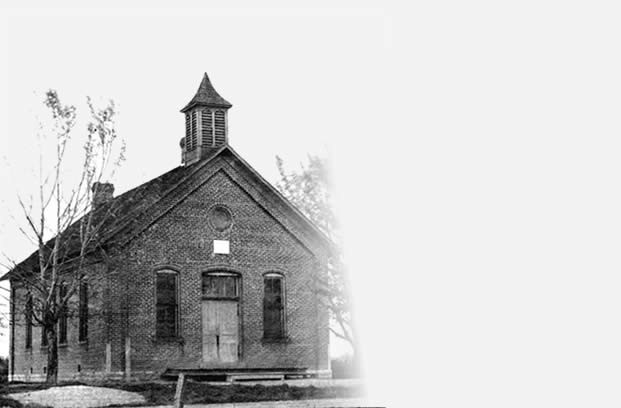Living Biographies
by Andrew Kay
Zelotes Eschmeyer, Reviewing Days He Spent as German Prisoner of War, Recalls How American Colored Troops Arrived on April 29 to Deliver Them From Prison Camp
The recent Prisoner of War experience of Homer Kuck of New Knoxville which appeared in the July 24 and 25 issues of The Evening Leader brought up the suggestion—“Why not see Zelotes Eschmeyer of R. R. 3, St. Marys, who was also a prisoner of war in Germany?” So we saw him.
Zelotes Eschmeyer lives on a farm at Carter Creek and is a neighbor of Riley Wilkins, Wilson Arnett, Richard Sudman, Hudson Bros. His wife is the former Mary Minnich of R. R. 1, St. Johns whom he married March 27, 1943, three days before he was drafted. Their only daughter, Joyce Ann is three years old and hasn’t the faintest idea what war is all about.
Up to the time when he was taken prisoner of war by the Germans, Zelotes’ military record is as follows: Entrained April 1, 1943 for Fort Benjamin Harrison, Indiana. He was there 10 days and was then transferred to Fort Riley, Kansas, where he received his basic training. After 13 weeks there he was sent to Camp Butner, N. C., where he continued 6 weeks, two of them at home on furlough. He next was sent to Fort Meade, Maryland, where he spent another 6 weeks, 5 weeks of which were spent in doing carpenter work in camp. Next he was transferred to Camp Shanks, New York, from which he left for their point of embarkation, crossed the Atlantic on the ship Capetown Castle, landed in Liverpool, was moved to Ireland and assigned to the 5th Division of the Infantry. By now it was November, 1943.
While in Ireland he chummed with a lad named Tom Skinion from New York and the two spent many an evening at the home of Mr. and Mrs. Harry Hanna. His buddy Tom Skinion is from New York City, but Zelotes has been unable to make contact with him since the war. On July 3, 1944 they sailed for France. On July 15 his unit went into the front line for the first time. He saw the first dead soldier a few days later. “He had been walking about 50 feet ahead of me. The platoon I was in cleared roads and mine fields, helped ferry ammunition and food across the Seine and Moselle rivers, set up road blocks etc. Up to the time that I was captured my platoon had three men wounded and one killed. In France we saw many dead cattle and horses. The French civilians treated us well when we met them in convoys or otherwise, and they would trade us eggs, apples, pears, honey etc. for cigarettes or chocolate, of which we always had plenty. We passed through St. Lo which was flattened by our bombers. We saw Verdun, a beautiful city. I remember clearly the battle of Angers and saw many dead Americans and Germans, a bloody sight. On September 16, 1944 I met Robert Gruebmeyer, a neighbor from home. Then came September 21. We were about 8 miles across the Moselle river and the third squad got orders to lay a road block. We got to a small town which was our destination. We had just finished laying the road block. It was 2:30 in the morning. Then suddenly the enemy shelled the town unmercifully. We sought cover in a building. We had planned to make a dash for the woods as soon the shelling ceased. But when we now looked through the windows we discovered that we were completely surrounded by the enemy, lots of them. We had to choose between surrender or instant death. Resistance was useless. They took us to their quarters about half a mile behind the lines and kept us there till morning. Now they moved us back 10 miles for questioning. That noon they put us on trucks and took us about 50 miles further behind the lines. There we were placed in a big brick building with other American prisoners. There were about 200 of us altogether. Here we stayed for 2 days and nights and were nearly eaten up by fleas and bed bugs. Then we were put into box cars, 50 men to a car, and we were in them 3 days and nights. We arrived at Stalag XIIA at Limburg. There we prisoners got our first Red Cross parcels, one parcel for 3 men one week, and for 2 men the next. Thanks to the Red Cross we received these packages as long as they were available. We spent 3 weeks in this camp. We ate sugar-beet soup, a few potatoes a day, coffee and a quarter or a sixth of a loaf of bread each per day.”
“After 3 weeks there, 499 of us American prisoners were moved to Stalag VIIA at Moosburg and had another miserable train ride going there. We had several air raids on the way. Here at Stalag VIIA I got my first shave and haircut. Here now I was made a member of a detail of 1000 men to 1500 American prisoners of war who daily went to Munich to clean up the wreckage of what our bombers had destroyed. We traded soap, tea and cigarettes for bread. It was verboten, but we did it. I was in this camp ordered to prepare to leave camp the next morning. With 23 others I was moved to barracks 29 at Wilheim and found that I was a member of a working party. I now had a comparatively nice place to stay, straw mattresses, double decker beds, and got more food than at Moosburg, but it was rotten. Fourteen of us were assigned to the water-works and 10 to the town. I had to work with the town carpenter, made window sash, tables, repaired damage, etc. I acted as Dolmetcher (interpreter) for our commander. He was a sergeant named Alfred Guth from Strasburg. On Feb 12, 1945 I accompanied him to Oberau to attend a Red Cross Conference. Here were two men from Switzerland and a German Major and Lieutenant. They discussed Red Cross parcels, treatment of prisoners, food, clothing, etc. On Feb. 17 I received my first letters from home, three of them. They made me terribly home sick. I had had no mail for 5 months and still had no word from my brother Eldred who was last heard from in England. I now worked 5 ½ days a week and washed my clothes and bathed on Saturday afternoons. I was paid 6 marks a week. The man I worked with was named Martin Straus. He was 52, and at the time one son had been killed in action, two wounded and the fourth one was missing. I was sometimes given an apple or a piece of bread by a civilian for whom we worked.”
“On Feb. 19 there was a big American air raid. We saw about a thousand planes. By now I was anxiously waiting for mail from mom and dad and the folks, and from Mary. I was always hungry. Thanks, thanks again for the Red Cross packages. Our daily schedule was as follows: Get up at 5:30 a. m.; have coffee at 6 a. m.; leave for work at 7:00 a. m.; dinner at 10 a. m.; work till 5 p. m. and then chow. Then we cleaned up, maybe did a little sewing, and then it was about bed time.”
“Feb. 21 was a red letter day. I sawed firewood in the morning and in the afternoon ripped, planed and joined lumber for a baby play pen. When I came back to camp in the evening I had 4 letters, one from Mary (his wife), one from Mom, one from Dad, and one from the Women’s Missionary Society. That night I had a bottle of cherry pop.”
“The next day three other war prisoners and I fixed the step in the air raid shelter, and in the afternoon made some repairs at our camp. We also made 70 stakes, 2 inches thick, 6 inches wide, 10 inches long, of white pine lumber. These were to be used as grave markers for the air raid victims. On Sundays we would have a church service, usually conducted by some one who had been to college or who was otherwise fitted to do this. By now we were having an air raid every day. One day I would have to make repairs at the air raid shelter, then we helped build an addition to the Krankenhaus (hospital), did some repair work at the Weisenheim (orphanage), and at the Oberschule (high-school), shoveled ashes, shoveled snow, worked at an Altenheim (where the sisters gave us each 2 cigarettes, and a mark), and at a private home where all four of us were given a jam sandwich. These jam sandwiches were as welcome as a big ice cream sundae on a hot summer day.”
His diary (which accounts for exact dates) reads in a similar vein, day by day. Tuesday, March 27 was a bright spot. Each of the prisoners received 4 Type-A Red Cross parcels. The daily entries from now until April 18 contain the following items, as regards work done: stacked lumber and started to build a wood-shed; sawed firewood; built flower beds at home for aged; built scaffold around air raid alarm; made double doors for air raid shelter; made handles for garden tools; took down and repaired, and then put up again, the town’s air raid siren.
But the tune suddenly changes on April 19, 1945. Wilheim was bombed today at 10:30 a. m. The Bahn-hof (rail road station) was blown to bits. “Did I sweat!” Then followed days and nights of tension, fright, uncertainty, more air raids, rumors, excitement. On April 29 came deliverance. It was at the hands of COLORED TROOPS, the advance units of the 116 Cavalry (mechanized), which crashed through and right up to camp. By this time the German guards had fled and the arrival of the American advance units was the signal of deafening applause, pathos, tears, and jubilation. THE LIBERATING UNITS WERE COMPOSED OF AMERICAN NEGRO TROOPS, a fact which Zelotes and his fellow prisoners of war will never, never forget.
The liberated prisoners of war were soon flown to Reims, France. On June 21 Zelotes came back to the States. He now received a 60 day furlough. Then he was sent to Florida for several weeks and from there to Camp Beale, California where he was mustered OUT on October 26, 1945. He had been separated from his wife exactly 21 months.
Living Biographies
by Andrew Kay
In 1949 and 1950, Reverend Edwin Andrew Katterhenry (1900-1963), a minister and a native of New Knoxville, wrote the “Living Biographies” feature for the St. Marys Evening Leader under the pen name of Andrew Kay. These articles consisted of interviews with aging citizens, many from New Knoxville and St. Marys, relating their experiences from their younger days. After Rev. Katterhenry passed away in 1963, his widow, Florence Katterhenry returned to New Knoxville to live out the remainder of her years until 1982. For those of us who are grandparents today, we remember her as “Mrs. K”. In the final “Living Biographies” article Andrew Kay wrote about himself, thus revealing his identity to the general public.


